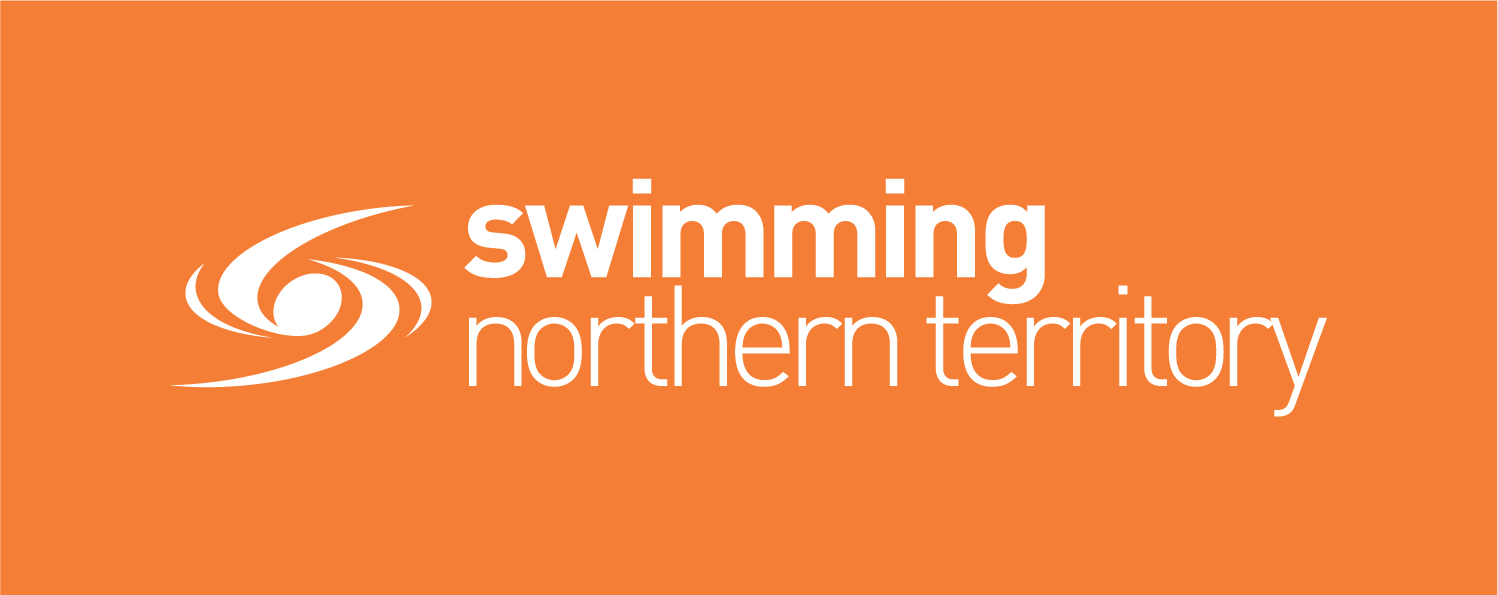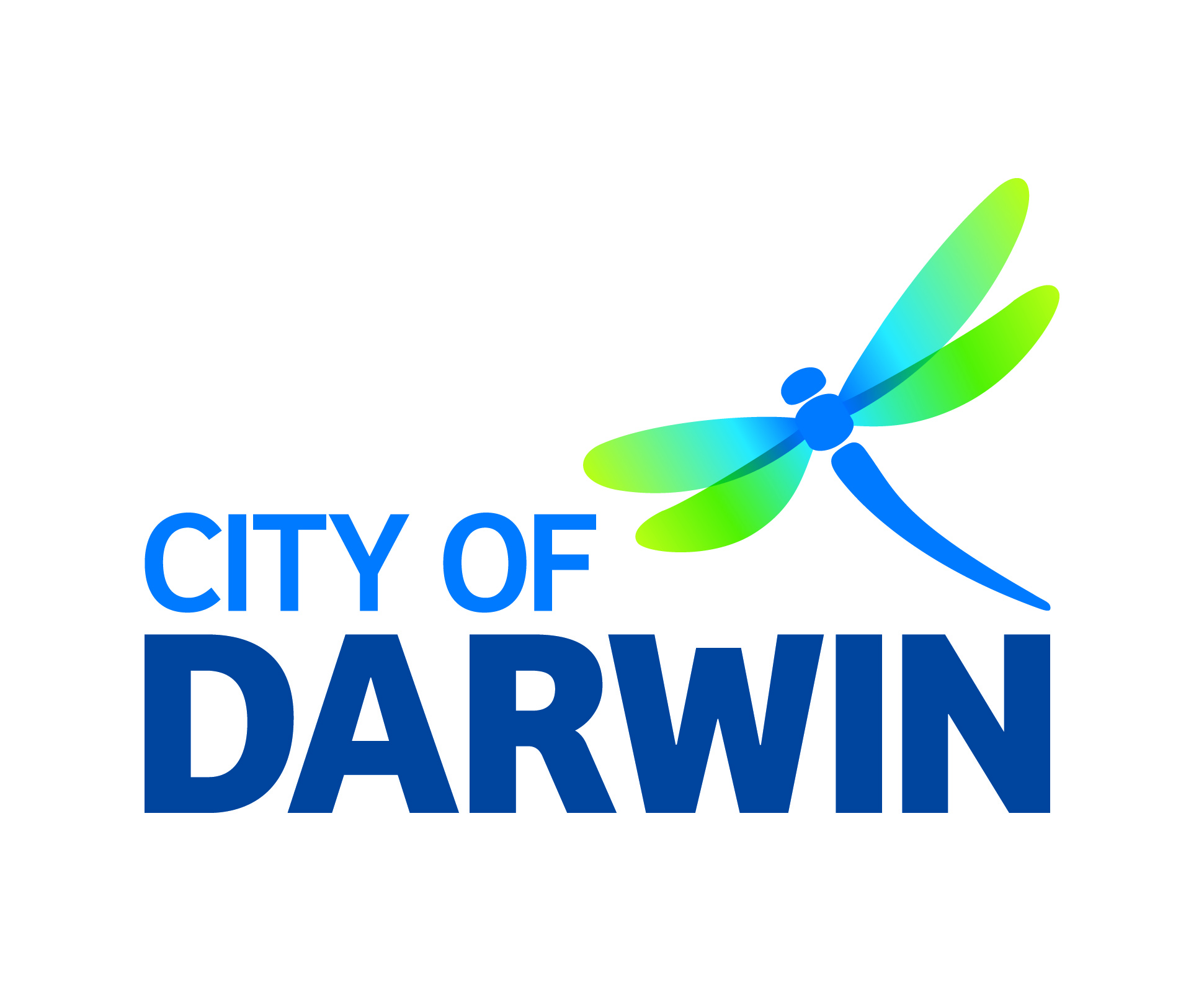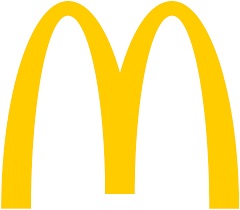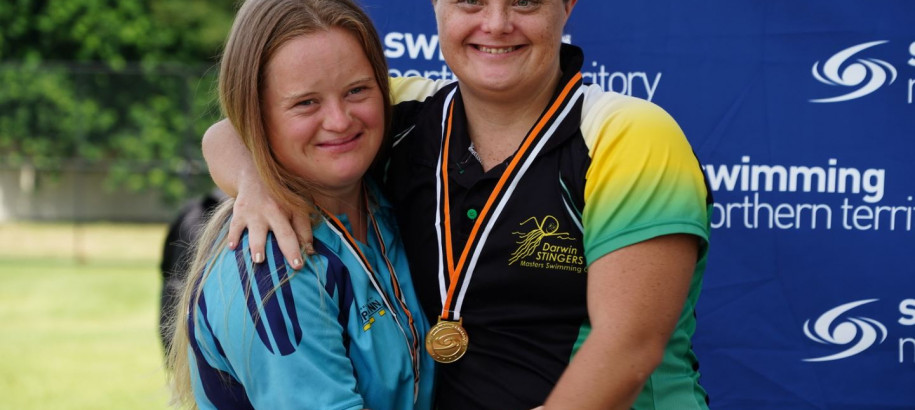
Swimming Northern Territory is committed to a swimming-for-all philosophy by creating opportunities for all Territorians to participate in our sport. Whether you choose to swim for fun and enjoyment, health and fitness or aspire to be a World Champion we aim to provide you with the opportunity to get involved in the swimming community and develop your aquatic skills.
Our vision for swimming in the Northern Territory is that it is known as an inclusive sport for all who desire to swim; regardless of skill, ability, location and cultural background. To help us bring this vision to life, we deliver a variety of programs and activities that help us reach swimmers from the city to some of the most remote communities in the Northern Territory.
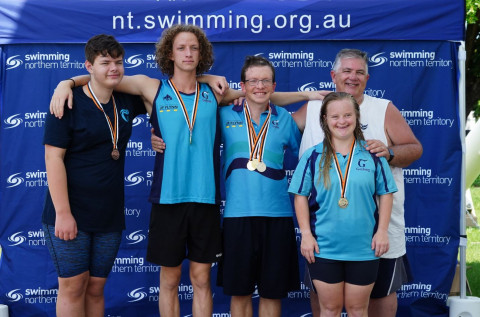
A visit from Grant(Scooter) Patterson and his coach Andrew(Herbie) Howard has provided inspiration and insight to further develop Swimming Northern Territories 'All-Abilities Initiative' and begin our new program in May this year.
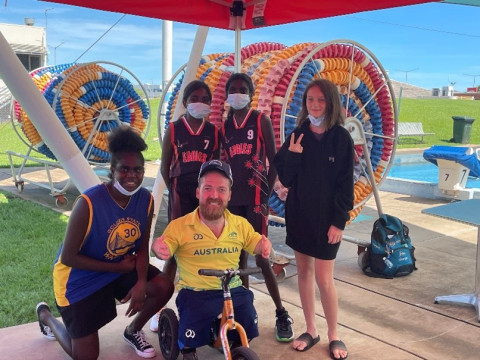
NT Swimming NT All-Abilities Initiative
- About our Program
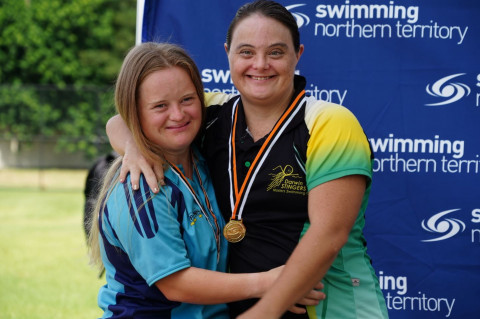
Kicking off in May 2022 Swimming Northern Territory with support from the NT Government is proud to be be rolling out our NEW 'All-Abilities Swimming Initiative'.
The initiatives aim is to give children in Darwin and Palmerston who have disabilities experience and access into the sport of swimming.
Swimming NTs 'All-Abilities Initiative' will consist of a fortnightly Swimming Group which will operate out of the Darwin based pools. Accredited program coaches who are trained to teach swimmers with a disability will teach the important skills of swimming and promote fitness. The group will be social based and allow participants to learn at their own pace in an inclusive and supportive environment.
Swimming offers pathways for individuals of all abilities who wish to become more involved in the sport and we aim that these sessions will provide a steppingstone for these athletes interested in gaining more information, knowledge and becoming more involved in club swimming.
The 'All-Abilities Swimming Initiative' is a FREE event for youth with a disability.
To get involved in our upcoming sessions please see our events page HERE…
Learn to Swim
- Why Learn to Swim
- Alleviation of pressure on joints and muscles
- Improving muscle strength
- Improving heart health
- Improving mental health
- Positive impacts on transfer skills
- Improving social wellbeing and having fun
- Supporting independence
- Questions to ask a Learn to Swim Program
- Is there a specific person within your organisation who can help me with swimming lessons for a child with disability?
- Do you offer one on one sessions?
- Do you offer a program that caters specifically for my child's ability?
- What type of pool access do you have?
- Can my child's access requirements be met?
- What time of day do you offer lessons?
- Do you provide the opportunity for off-peak lesson times as these may be preferential for my child?
- Do you offer trials or flexible lessons?
- Do you offer makeup lessons?
Swimming offers a wide range of benefits to people who live with disability. This includes benefits such as:
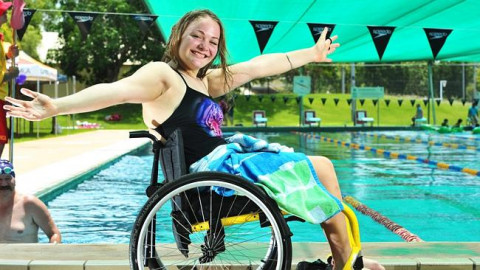
The NT is renowned for it's great fishing and majestic water holes which we love swimming in. But, for many people and children, their association with the water and swimming begins with learning to swim. Swimming is great for people of all ages, and it is never too late to learn.
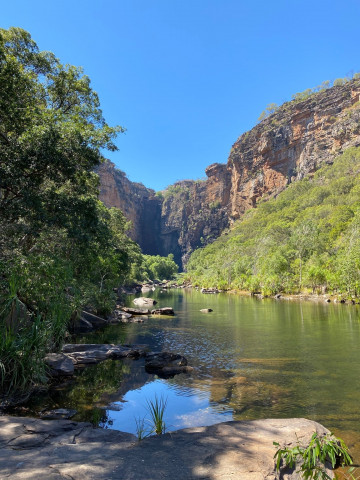
There are many learn to swim and swimming lesson programs available in the Northern Territory which accommodate swimmers with varied levels of ability.
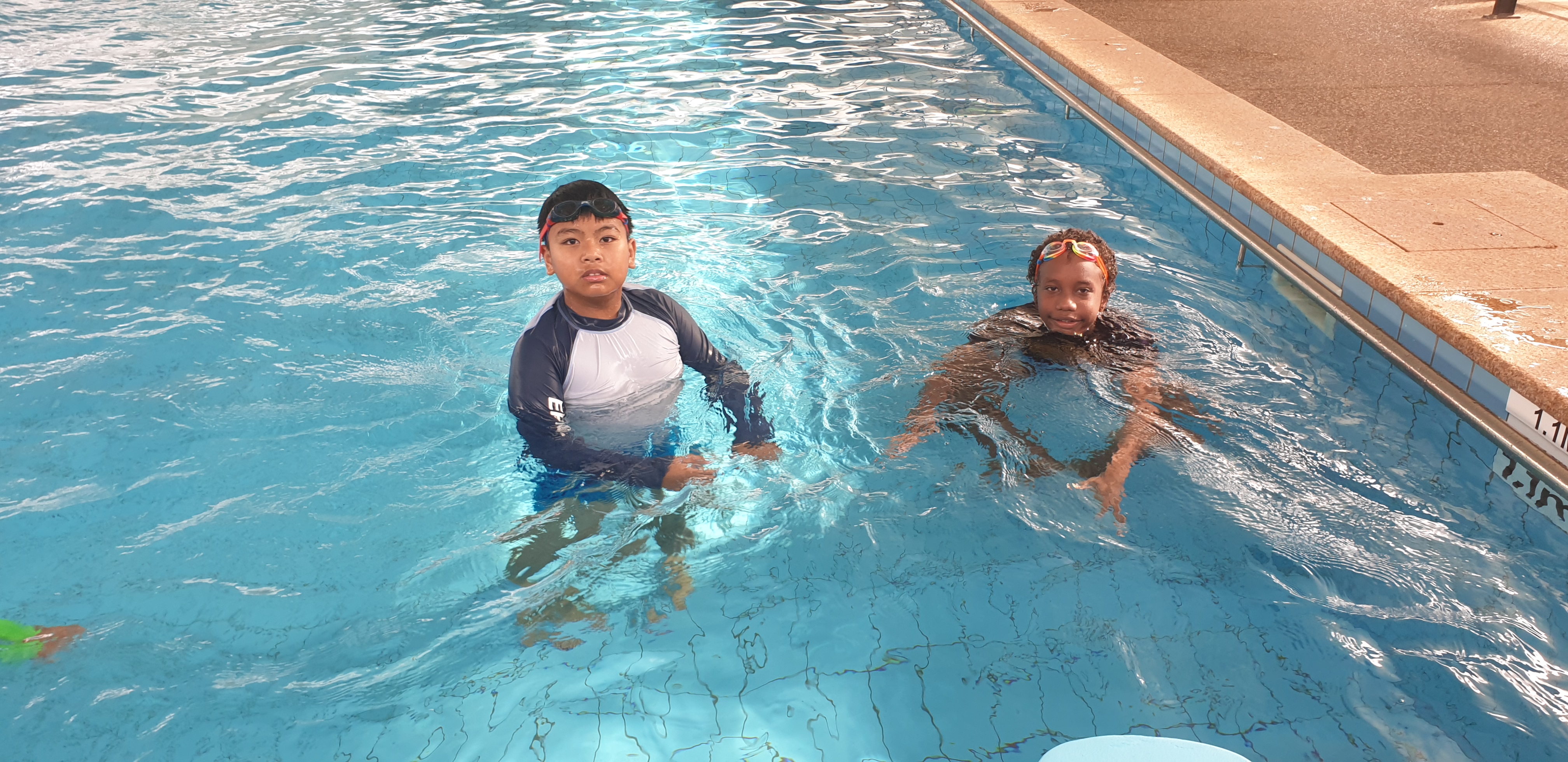
To find a suitable learn to swim program, simply search for a Learn To Swim program that is near or convenient for you.
Some tips and questions you may like to ask your local learn to swim provider:
Join a Club
- Multi Class Swimming at our Clubs
- Questions to ask you new Club
- Do you offer a swimming squad that will cater specifically for my child's ability?
- Is there a specific person with experience who would be supporting my child/or me?
- What type of pool access do you have?
- Can my child's access requirements be met?
- Do you have a trial period?
Swimming Northern Territory encourages each of our Clubs to adopt the Swimming Australia’s Inclusive Swimming Framework, which encourages a ‘swimmer first’ approach – catering to the individual need of the club member. Please see Link if you would like to read more about this Framework
If you’re interested in joining a club, we suggest checking out our FIND A CLUB link at our website that lists the clubs in the Northern Territory. Make sure you take the opportunity to visit the club, talk to their coach and committee to ensure that it suits your individual needs.
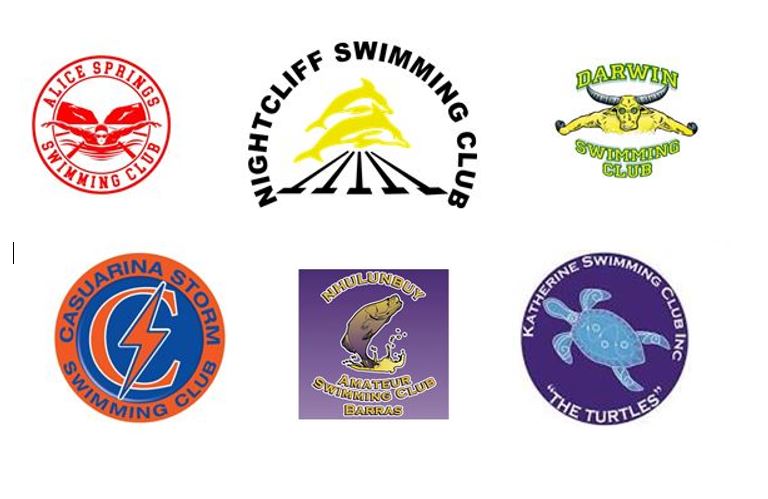
Provided below are some tips and questions you may like to ask your local club or club of choice:
Classification
- An Overview
- The prefix S denotes the class for Freestyle, Backstroke & Butterfly
- The prefix SB denotes the class for breaststroke
- The prefix SM denotes the class for Individual Medley
- Transplant Recipient - Class 16
- Deaf and Hard of Hearing - Class 15
- Intellectual Impairment - Class 14,18 and 19
- Visual Impairment - Class 11-13
- Physical Impairment - Class 1-10
- Transitioning Classification - Class 17
- When is Classification Required
- How to get Classified
- Classification Pathway
There are 19 classes in the swimming classification system which cater for a range of disabilities. Each class has minimum eligibility requirements and swimmers must undergo specific Athlete Evaluation or Eligibility process to obtain a classification.
These classifications underpin multi class swimming and provide a fair system when swimmers with disability compete.
Swimmers receive a class for each stroke discipline, and a prefix indicates which stroke the class applies to.
For example - These letters will appear before the classification number e.g. S3, SB2, SM3 or S14, SB14, SM14.
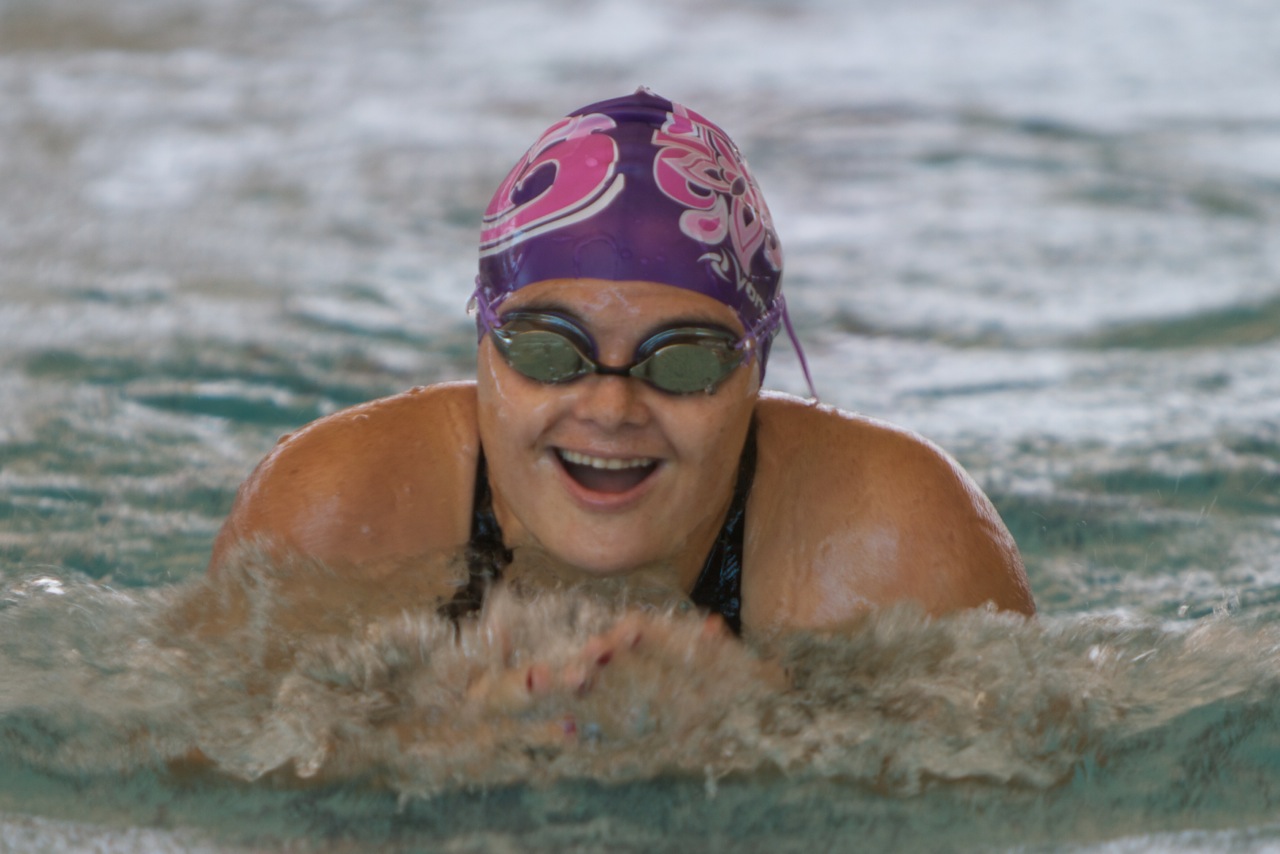
Exceptions
Some swimmers may also receive exceptions to the swimming rules based on their classification, which prevent classified swimmers being disqualified during Multi Class competition. These exceptions will be determined during the classification process. You can find a list of the Swimming Codes of Exceptions at the following links - National and International
More information about the classification classes including the classification guide and exception codes can be found on the Swimming Australia website.
Swimmers who have received a transplant (Class 16)
Any person having undergone invasive treatment of a non-cosmetic nature requiring organs and/or tissues (excluding blood) donated by another person.
Swimmers with Hearing Loss (Class 15)
Swimmers who have a recognized hearing loss according to the following ICSD standards; deaf, defined as a hearing loss of at least 55dB in the better ear 3FAHL
Swimmers with Intellectual Impairment (Classes 14,18,19)
Intellectual Impairment Virtus II-1 class S14
Swimmers with an IQ score of 75 or less; with significant limitations in adaptive behaviour expressed in conceptual, social, and practical adaptive skills; acquired prior to 18 years of age.
Intellectual impairment with a significant other impairment Virtus II-2 S18
Swimmers with a formal diagnosis of Down syndrome including type (Trisomy 21, etc.). For safety, athletes must not have symptomatic Atlantoaxial Instability (AAI)
Swimmers with intellectual disability who have satisfied the II-1 eligibility criteria, and meet the FAST test requirements
Note: Mosaic Down syndrome is not an eligible criteria for II-2
(High Functioning) Autism Virtus II–3 class S19
Swimmers with a Full-Scale score IQ of above 75, OR no diagnosis of intellectual disability, and; a formal diagnosis of Autism, ASD or Asperger’s syndrome
Note: Swimmers with Autism who meet the criteria for II1 intellectual disability will be classified in that class.
The new S18 and S19 participation swimming classes are currently being trialled across Australia, with Swimming Australia planning to formally announce the addition of these classes shortly.
These new participation classes will be included in the upcoming Australian Age Swimming Championships, however these classes will not be included in the Australian Swimming Championship, an event which is a selection trials for High Performance Teams in 2022.
This decision was made to ensure that Swimming Australia review implementation of the trial across Australia at State level and the Age Championships, while also working with the Swimming Australia High Performance Team and Sport Inclusion Australia to identify how the classes can be best implemented within the event in the future to meet the needs of swimmers and the competition.
Swimming Australia will roll out further education and communication material that will be added to this toolkit when there is a formal announcement of the classes.
Swimmers with Vision Impairment (Classes 11-13)
Ranges from Class 11 for swimmers who are blind to Class 13 for swimmers who are legally blind (i.e. acuity less than or equal to 6/60 or visual filed less than 20 degrees).
Swimmers with Physical/Functional Impairment (Classes 1-10)
Swimmers are assessed through physical testing and water observations. Muscle strength, movement co-ordination, joint range of movement and limb/trunk length contribute to the allocation of classes. Classes range from swimmers with most significant physical impairment (Class 1) to those with minimal impairment (Class 10).
Any person having previously been classified in the S1-16 pathway who is has or has had one or more of the above-mentioned impairments that currently not eligible or has the potential to be eligible in the future in the S1-16 classification range as determined by Swimming Australia.
For more information on the classes and eligibility requirements visit the National Classification Explanatory Guide and Multi Class Engagement Portal on the Swimming Australia website HERE
For Intellectual impairment eligibility you can also visit the eligibility section of the Sports Inclusion Australia website.
Classification is required to compete in multi class competition at state, national and international level.
A Provisional classification is required to compete at school, club, local and regional levels of competition. The process to obtain this entry level classification sees a participant working with their home medical contact and provide supporting evidence to their application. This is then forwarded to an accredited classifier to assess and determine an outcome of eligibility.
A National classification is required to compete at state and national level competitions. This involves a face-to-face evaluation conducted by accredited classifiers
International classification is required to compete internationally. This process also involves a face-to-face evaluation conducted by accredited classifiers
More information about the classification process including the national classification Master List can be found on the Swimming Australia website.
Swimming Australia has simplified the process of getting classified through the Multi Class Swimming Engagement Portal.
By completing a few short questions about yourself, the portal will help you determine if you might be eligible to be classified. From there you’ll be provided with the information you need to go and get classified.
Multi Class Swimming Engagement Portal can be accessed at the following link to begin the process of getting classified. Portal Access
Once a swimmer is classified, their details are recorded in the National Swimming Classification Master List, which is published to assist swimmers and meet officials to identify current classifications.
Swimming Australia members who have completed the Athlete Evaluation process will receive a classification card (presented on their Swim Central membership card) that indicates their eligible classifications, exceptions and National Sport Class Status.
In order to be classified, swimmers will need to undergo an Athlete Evaluation Process. The image below provides an overview of Swimming Australia’s Classification Pathway.
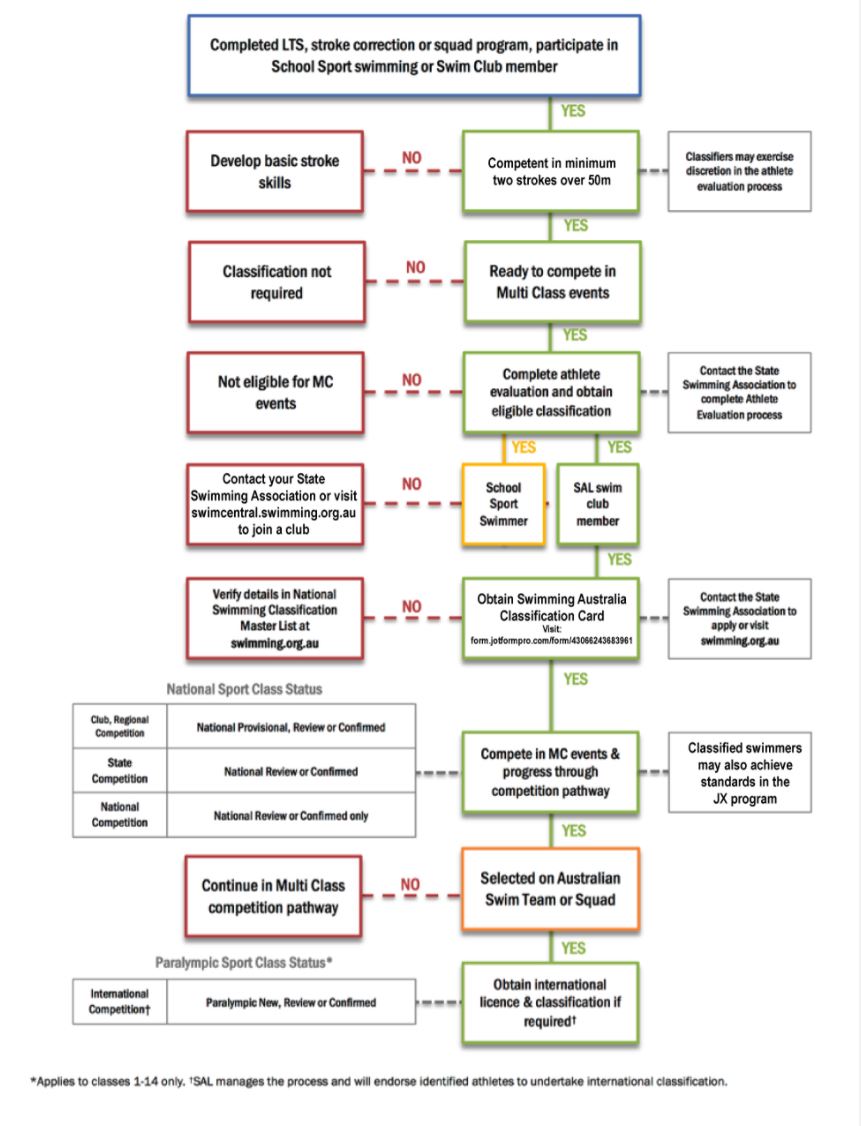
For more information on this pathway please go to the Swimming Australia Classification Policy
Competition Opportunities for Swimmers with Disability
- What is Multiclass Competition
- How are the Results and Places Determined
- Competition Pathways
- Classification Cards for Competition
- Classes (e.g. S8 SB7 SM8)
- Login to Swim Central
- On the menu list, select the ‘Profiles’ tile and select ‘View Profile’ (if you are a parent/guardian, select the relevant dependent)
- Select the active club membership. This will showcase the membership card and present the classification information.
Multi Class competition provides a fair approach for swimmers with disability by grouping them according to their classification.
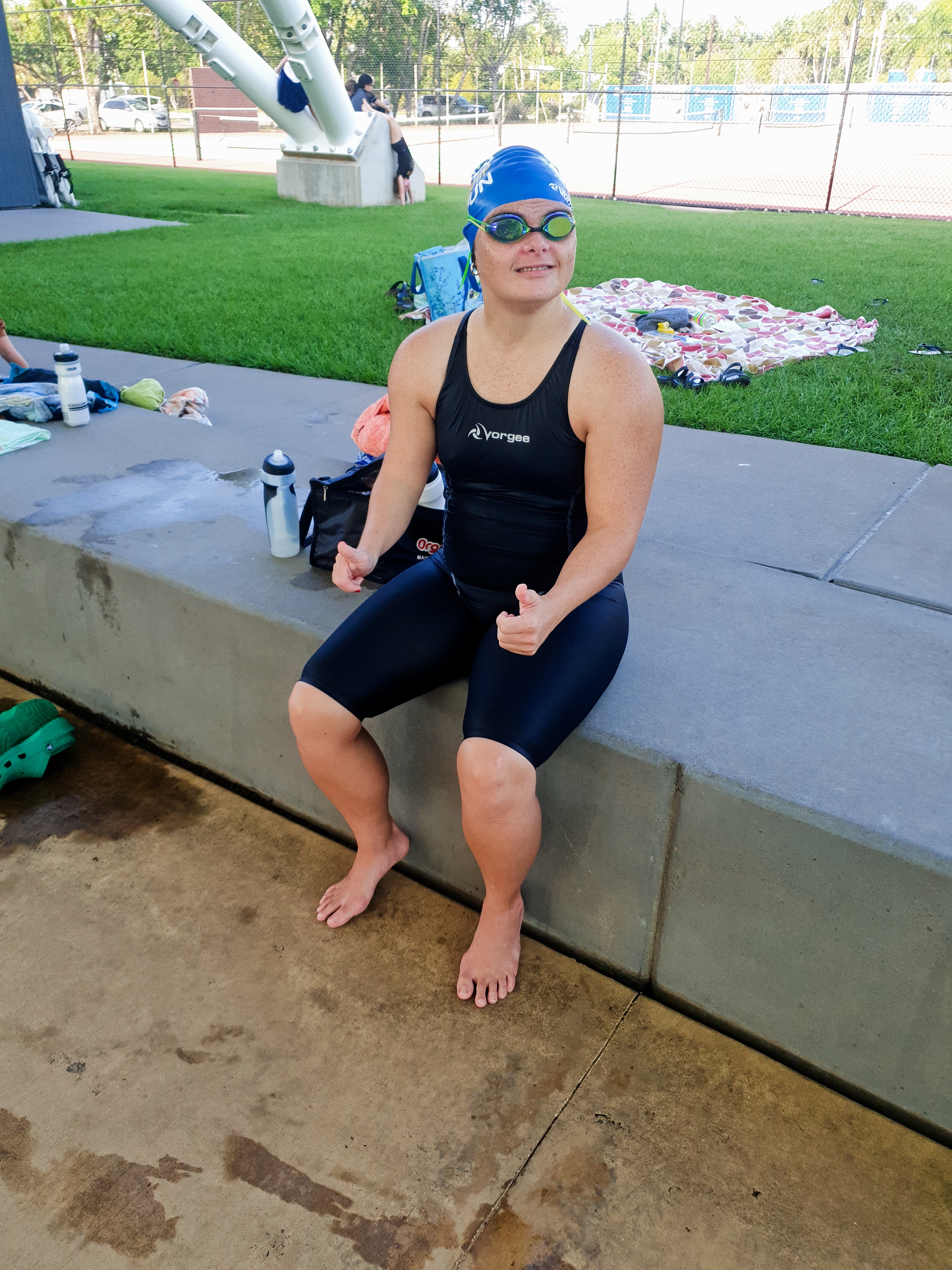
Swimming Northern Territory encourages Multi Class competition to be integrated wherever possible at all levels of competition.
Once classified, a swimmer with disability is eligible to compete in Multi Class races according to their classification and National Sport Class Status, which determines the level of competition the swimmer may compete in (i.e. club, regional, state or national level meets).
Swimmers with disability may compete in an able-bodied event and have any relevant exceptions to the swimming rules applied, so long as the equivalent multi class event is not in the meet program. This is likely to be the case at smaller events such as club and regional meets.
Some competitions include multi class events that cater for swimmers with disability in which any relevant exceptions to the swimming rules are applied. Swimming Northern Territory incorporates multi class events into each of our Championship events, and where appropriate our preparation meets.
Check out our Upcoming Events and Events Calendar for upcoming events.
Multi Class results are calculated according to a swimmer's classification. This means that the first person to touch the wall in a race will not necessarily be the official first-place getter.
The Multi Class Point Score Calculator (MCPS) determines the results and official placing for Multi Class events. This score is based off the World Record for their class as at 1 October, awarding points to the competitor according to how close they are to the World Record.
You can view your Multi Class Point Score for an individual result using the Online Multi Class Point Score Calculators at the following link Multi Class Point Score Calculators and Base Times
There are several competition pathways for all athletes within each of the class types.
Para Swimming - physical, visual & intellectual impairment
Multi Class competition at an international level is sanctioned by the International Paralympic Committee (IPC) and includes events such as the Paralympics.
To compete at IPC approved and sanctioned competitions, swimmers must obtain International Paralympic Classification. Generally, swimmers with disability who are selected on the Australian Dolphins Swim Team are invited to undergo International Paralympic Classification by the Swimming Australia Para High Performance Manager.
All swimmers with a current international Paralympic classification can be viewed on the IPC International Swimming Classification Master List,
Special Olympics - intellectual impairment
Deaflympics – deaf and hard of hearing
Transplant Games - Transplant Recipient
Virtus - intellectual impairment & Autism
More information about pathway opportunities can be found on Swimming Australia website.
The Swimming Australia Classification Card is intended to assist the effective management of Multi-Class Competition. It provides an official record of an individual competitor’s classifications and any applicable rule exceptions. The Classification Card proves eligibility to compete in Multi-Class competition or other competition where classifications and rule exceptions are enforced. The card is issued to swimming club members who have an eligible swimming classification.
Over the past 10 years or so it has been common practise to present a classification card to the relevant Technical Official at swim meets to prove eligibility. Swimming Australia is now phasing these physical cards out and moving the information that is contained within the National MC Masterlist into Swim Central.
Your classification information will now show on your membership card in Swim Central similar to the following example:
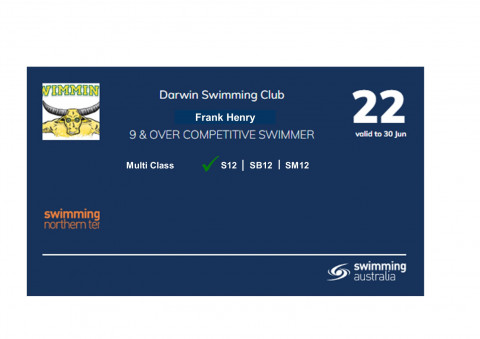
! Exceptions (e.g. *A 6,9)
i Review year (e.g. 2022)
Note: exceptions that contain a * signify that the member contains an exception that is applied from the IPC code of exceptions.
IPC Code Exceptions can be found here. (Nationally classified swimmers)
WPS Code Exceptions can be found here. (Internationally classified swimmers)
To locate this within Swim Central:
When required, you may be asked to present this information to meet organisers. To do so, you can pull this up on a device (whether screenshotted or by logging into Swim Central) or alternatively print off and have on hand.
Meet organisers are also able to refer to the Swimming Australia Masterlist which shows eligibility of all classified participants: https://www.swimming.org.au/swim-1/compete/classification.
Swimming NT Partners
- Partners
Local Partners
Variety NT Starfish Swim Group
Website Link : Starfish Group
Facebook : Variety NT Starfish Swim Group
Phone : Donna 0437 112 633
Email : paulrousham@bigpond.com
Total Recreation NT
Website Link: Total Recreation NT
Facebook : Total Recreation NT Facebook
Phone : (08) 8981 3686
Email : admin@totalrecreation.org.au
National Partners
Special Olympics
Special Olympics provide participation and competitive sporting opportunities for people with an intellectual disability across Australia. The flow chart below will help you determine the best path, as a swimmer with an intellectual disability. The database below, is an updated list of Clubs in Special Olympic regions that can cater for swimmers with an intellectual disability.
Web Link: https://www.specialolympics.com.au/
Facebook: https://www.facebook.com/SpecialOlympicsAustralia/
Phone: 1300 225 762
Paralympics Australia
Paralympics Australia is the peak national body responsible for Australia's elite athletes with a disability. They are responsible for Paralympic classification (Classes 1-14), Talent Identification and Paralympic Education Programs. For Vision Impairment Classification, please contact them directly.
Web Link: https://www.paralympic.org.au/
Facebook: https://www.facebook.com/AUSParalympics/
Phone: Contact us via phone (+61 2 9704 0500) or email
General: info@paralympic.org.au
Fundraising: fundraising@paralympic.org.au
Get involved in Para-sport: register your interest
Classification: classification@paralympic.org.au
Deaf Sports Australia
Deaf Sports Australia (DSA) is the peak body for deaf sport in Australia. DSA manage deaf specific competitions, promote the participation of people who are D/deaf or hard of hearing in sport and manage eligibility for hearing loss classification (Class 15)
Web Link: : https://deafsports.org.au/
Facebook: https://www.facebook.com/deafsportsaust
Sport Inclusion Australia
Phone: 03 5762 7494
Web Link: https://sportinclusionaustralia.org.au/
Email: mail@siasport.org
Facebook: https://www.facebook.com/Sport-Inclusion-Australia-129956998912/?fref=ts
Blind Sports Australia
Phone: (03) 9864 9409
Web Link: https://www.blindsportsaustralia.com.au/
Facebook: https://www.facebook.com/BlindSportsAust/
Resources
- Resource List
- The NDIS recognises the holistic benefits of swimming and can provide funding for either your sporting activities themselves or part of your sporting equipment. Just keep in mind, funding can only be provided for supports that are considered to be reasonable and necessary and relative to the goals in your NDIS plan.
- The NDIS can also fund specialised sporting equipment that's relative to your disability. This comes under one of two categories:
- Consumables: For sporting equipment you can buy “off the shelf” but have to pay more because of the adaptations needed to meet your needs. You cover the cost of the basic product and the NDIS funds the difference. While the NDIS won’t cover the full cost, it can cover what you have to pay over and beyond the base price. For example, if you need a specialised saddle for horse riding, you cover the cost of a standard saddle and the NDIS covers the cost of any extra modifications.
- Assistive Technology: For complex equipment from a specialist disability supplier. An OT assessment is needed for this type of equipment confirming it's suitable for your needs and is reasonable and necessary.
Special Olympics Online Learning - Inclusive Sport Academy
Designed to help enhance skills and abilities within the sporting sector. It provides a bespoke destination with resources, courses, video and workshops. Importantly, content has been developed with a cohort of Special Olympics Athlete Leaders to ensure people with intellectual disabilities or autism had a voice on the platform. The Academy wishes to ensure that the online learning platform drives meaningful outcomes for people with intellectual disabilities or autism and becomes an integral component of disability sports education providing more opportunities for individuals to develop skills, grow, learn and lead.
NDIS - Providers and Access to NDIS funding
Links:
Club Leadership Handbook - Special Olympics
Australia's Disability Strategy 2021-2031
